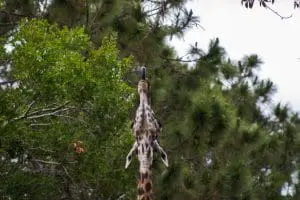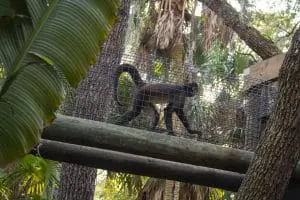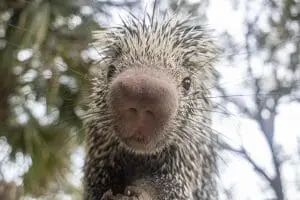

Where are the giraffe? Oh, in those trees.
You’ve made it to our Zoo and head straight to your favorite animal resident – maybe our giraffe herd or our Florida black bear trio – only to be greeted with an empty habitat. We know how frustrating it can be to not see your favorite Zoo animals sometimes!
We also know that our guests and our Zoo animal care team both want to experience the same thing: exciting opportunities to see healthy animals acting on their natural behaviors. To that end, we believe providing our animals with meaningful choices and control over their daily lives is essential to their wellbeing. So, our residents can choose from many options throughout their day, from what to eat to, yes, where to spend time in their habitat.
But wait! What actually ARE meaningful choices for animals under human care? Why do these options matter? Read on to learn more!
Meaningful Choices
 When we say the Zoo gives animals meaningful choices, it means we are giving them opportunities to choose things relevant to what matters to them, said Ellen Dreyer, an animal wellbeing consultant for our Zoo. Our giraffe can act on their natural desire to strip leaves from tree branches in their main habitat, but if we gave that opportunity to our alligator Martha, it wouldn’t be a meaningful choice since she has no interest in eating leaves.
When we say the Zoo gives animals meaningful choices, it means we are giving them opportunities to choose things relevant to what matters to them, said Ellen Dreyer, an animal wellbeing consultant for our Zoo. Our giraffe can act on their natural desire to strip leaves from tree branches in their main habitat, but if we gave that opportunity to our alligator Martha, it wouldn’t be a meaningful choice since she has no interest in eating leaves.
While the terms “choice” and “control” are often used together, they’re two different concepts. An example of choice, or the act of making a decision when faced with multiple possibilities, is giving an animal the option of several hammocks or hides to use. Providing a mister for a resident to turn on and off is an example of giving them control, or the power to direct a course of events.
Animals who do not have choice and control often experience higher stress levels. Our animal care teams monitor their residents for any negative indicators of welfare, like stereotypic behavior, or repetitive behaviors with no set purpose. Examples include pacing, swaying, head-bobbing, over-grooming or excessive licking.
Other examples of negative behaviors caused by a lack of meaningful choices and control include lethargy, signs they are having trouble coping with stressors, and something called “learned helplessness,” Ellen said. Learned helplessness occurs when an animal may internalize the idea that his or her actions have no effect on their environment and stop showing appropriate natural behaviors.
On the flipside, we know choice and control are benefitting our animals because we see positive species-specific behaviors related to the options we provide. Decisions like our kangaroos choosing to sleep under the many shade options in their habitat or graze using a variety of feeding contraptions tell us we’re meeting one of their needs and giving them an outlet for it.
Let’s get into those options we provide:
Den Sweet Den
Providing animals with a choice of where to spend their time is an important part of making them comfortable and providing them with the ability to self-regulate and perform species-specific behaviors, Ellen said.
 For some of our animals, having the choice of where to spend their day is a natural need. In their native range, black-handed spider monkeys practice what’s called a “fission-fusion social structure.” During the day, spider monkeys usually opt to break up into smaller sub-groups to forage for food before coming together again at night. Our troop can practice this natural social structure in the Zoo thanks to the tunnel system we created to connect them to three different habitats! They get more than just a change of scenery.
For some of our animals, having the choice of where to spend their day is a natural need. In their native range, black-handed spider monkeys practice what’s called a “fission-fusion social structure.” During the day, spider monkeys usually opt to break up into smaller sub-groups to forage for food before coming together again at night. Our troop can practice this natural social structure in the Zoo thanks to the tunnel system we created to connect them to three different habitats! They get more than just a change of scenery.
All our animals need a place to retreat as well. Sometimes we all need to get away from our family or roommates, right? Our animal residents also need areas to withdraw from their habitat-mates or, yes, from our guests as well. Remember the tree line at the back of our giraffe veldt we mentioned earlier? It gives our giraffes a chance for quiet privacy. It may not be ideal for the day you choose to visit, but it’s necessary for healthy, stress-free giraffes. Without it, we might see those stereotypical behaviors or signs of stress from our giraffe if they feel overwhelmed by their (adoring) fans.
Next time you visit, keep an eye out for the options we give our animal residents on where to spend their time: hammocks, hides, night boxes, night houses, dens, and even landscaping can offer them a place to rest or get out of sight.
There is no Participation Trophy – Just Snacks
Barring any major medical emergency, many of our animal residents are given the choice to participate in almost everything we ask of them.
Our animal residents only experience positive reinforcement when they participate – there are no consequences for not acting on a cue from their keepers. But, there are plenty of rewards – either a snack or something more tactile like a scratch for participating! By giving our animal residents the option of participating, we lessen their stress and avoid any unintended negative consequences.
 Many receive training on behaviors we’d like them to do during different wellness procedures. Most of our Grevy’s zebras are trained to receive voluntary hoof trims, which is the shaping of their hooves to avoid issues like overgrowth, arthritis and fractures. Their animal care team worked to get our zebra (minus our newest foal!) comfortable with every aspect of a trim, from lining up along the trimming block to holding their foot in place. By giving them the choice to participate, we avoid needing to sedate or restrain our zebras for a hoof trim, which can cause stress, injuries and more.
Many receive training on behaviors we’d like them to do during different wellness procedures. Most of our Grevy’s zebras are trained to receive voluntary hoof trims, which is the shaping of their hooves to avoid issues like overgrowth, arthritis and fractures. Their animal care team worked to get our zebra (minus our newest foal!) comfortable with every aspect of a trim, from lining up along the trimming block to holding their foot in place. By giving them the choice to participate, we avoid needing to sedate or restrain our zebras for a hoof trim, which can cause stress, injuries and more.
Other training our animals may receive include learning to hop on a weight scale when asked, remaining in place for an injection, and opening their mouth for an exam.
 For one group of animal residents, this option to participate or not goes a step further. Our Animal Ambassadors, like our prehensile-tailed porcupine Shelley, “star” in educational programs, special events, Zoo Chats and more. They and their animal care team bring conservation lessons – and fun experiences – to guests. It’s important work but not more important than their wellbeing. Their keepers “ask” them whether they’d like to join a public activity in a variety of ways. For Shelley, this means being given the option to enter her secure carrier. Their keepers also “read” their behavior during these events in case they may need to end early for the Ambassador Animal’s comfort.
For one group of animal residents, this option to participate or not goes a step further. Our Animal Ambassadors, like our prehensile-tailed porcupine Shelley, “star” in educational programs, special events, Zoo Chats and more. They and their animal care team bring conservation lessons – and fun experiences – to guests. It’s important work but not more important than their wellbeing. Their keepers “ask” them whether they’d like to join a public activity in a variety of ways. For Shelley, this means being given the option to enter her secure carrier. Their keepers also “read” their behavior during these events in case they may need to end early for the Ambassador Animal’s comfort.
Enriching Experiences
Enrichment gives our animal residents a physical and mental outlet – as well as more choice and control over how to spend their day. We strive to give them enrichment opportunities that elicit natural behaviors.
Some examples include:
- Habitat enrichment –By changing up a habitat, it keeps the space fresh for our animal residents. Just ask our goats in The Barnyard! By moving their climbing structures around, it makes those items THAT much more fun to clamber on!
- Sensory enrichment – Did you know our lions are big fans of men’s cologne? Or that our bald eagles love working through different substrates to find snacks? Giving our animals different things that interest their senses encourages them to explore their habitat.
- Food enrichment – Most of our animal residents’ counterparts in their native range spend a lot of their time foraging for food. They experience this at our Zoo as well! Our animal care team hides food among different objects – from trees to kongs – for our black bears to find and enjoy. The bears can even opt for some more immediate snacks by accessing an automatic feeder!
Choice and Control
Providing our animal residents with meaningful choice and control over their lives is as necessary as giving them comfortable habitats, nutritious food and good medical care. We want to make sure every animal in our care has the best possible physical, mental and emotional health from birth to old age. Our focus on animal wellbeing is core to our culture and at the heart of all we do. We hope you feel that on every visit – even if you might not see EVERY one of our animal residents!
